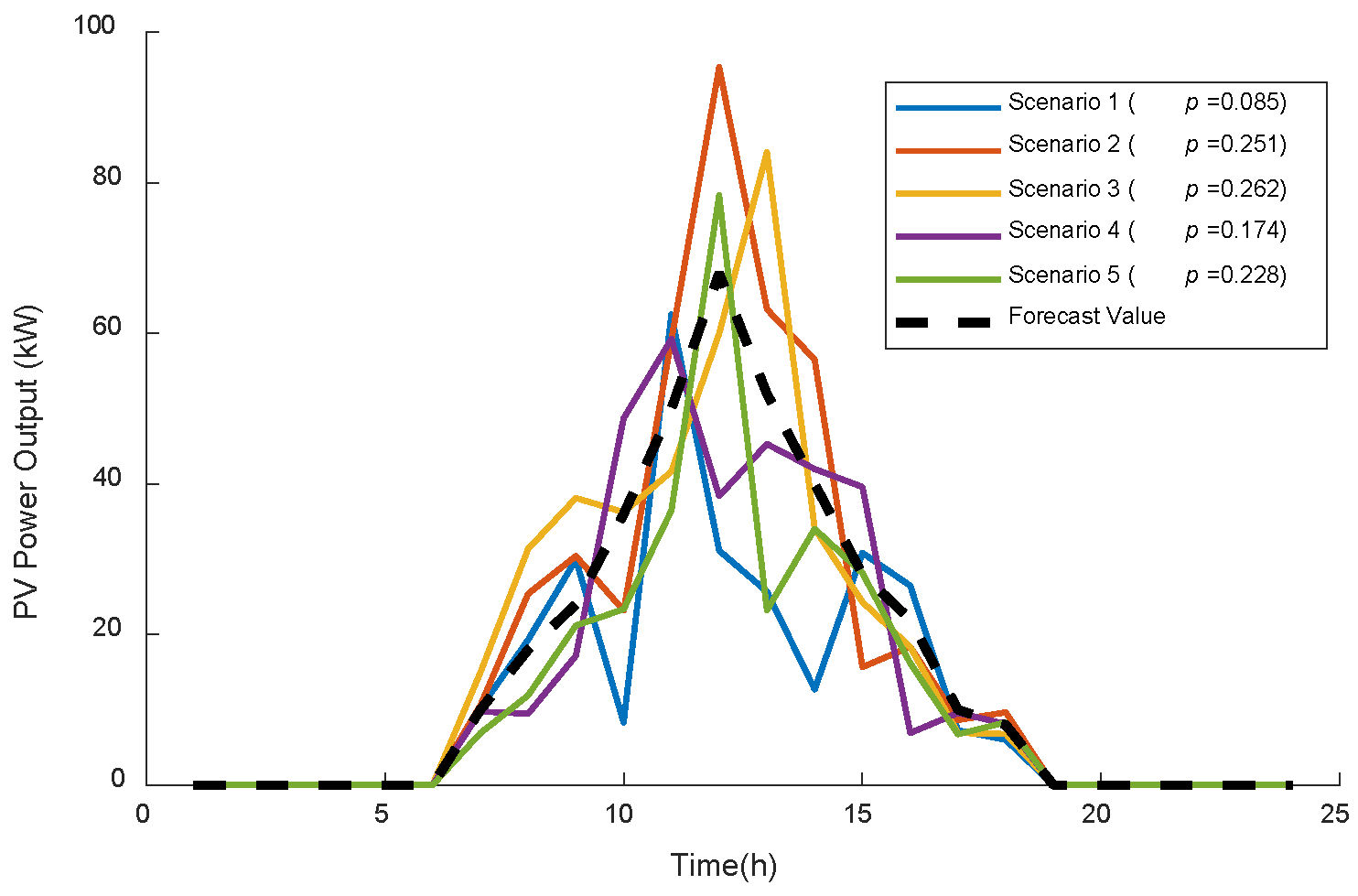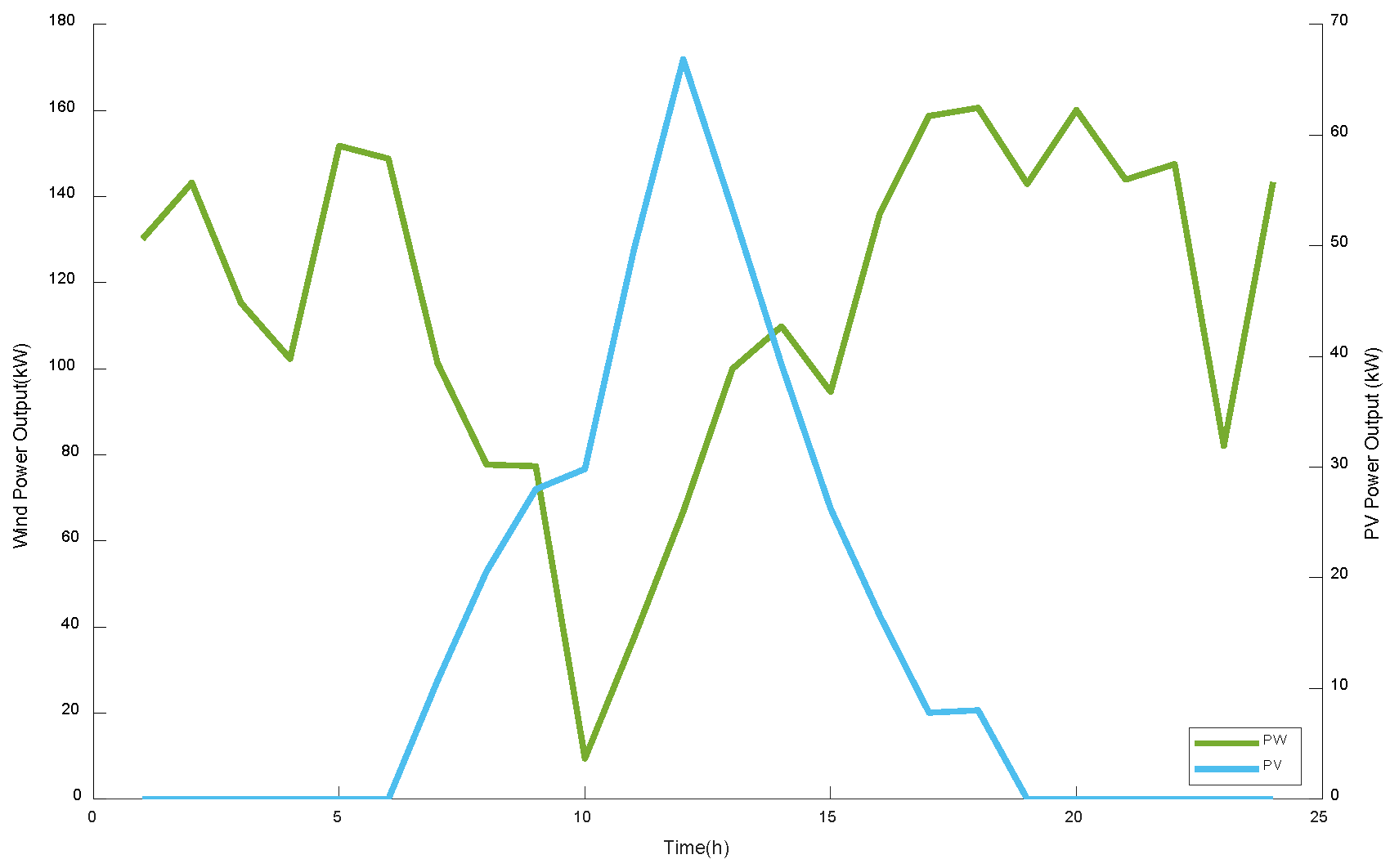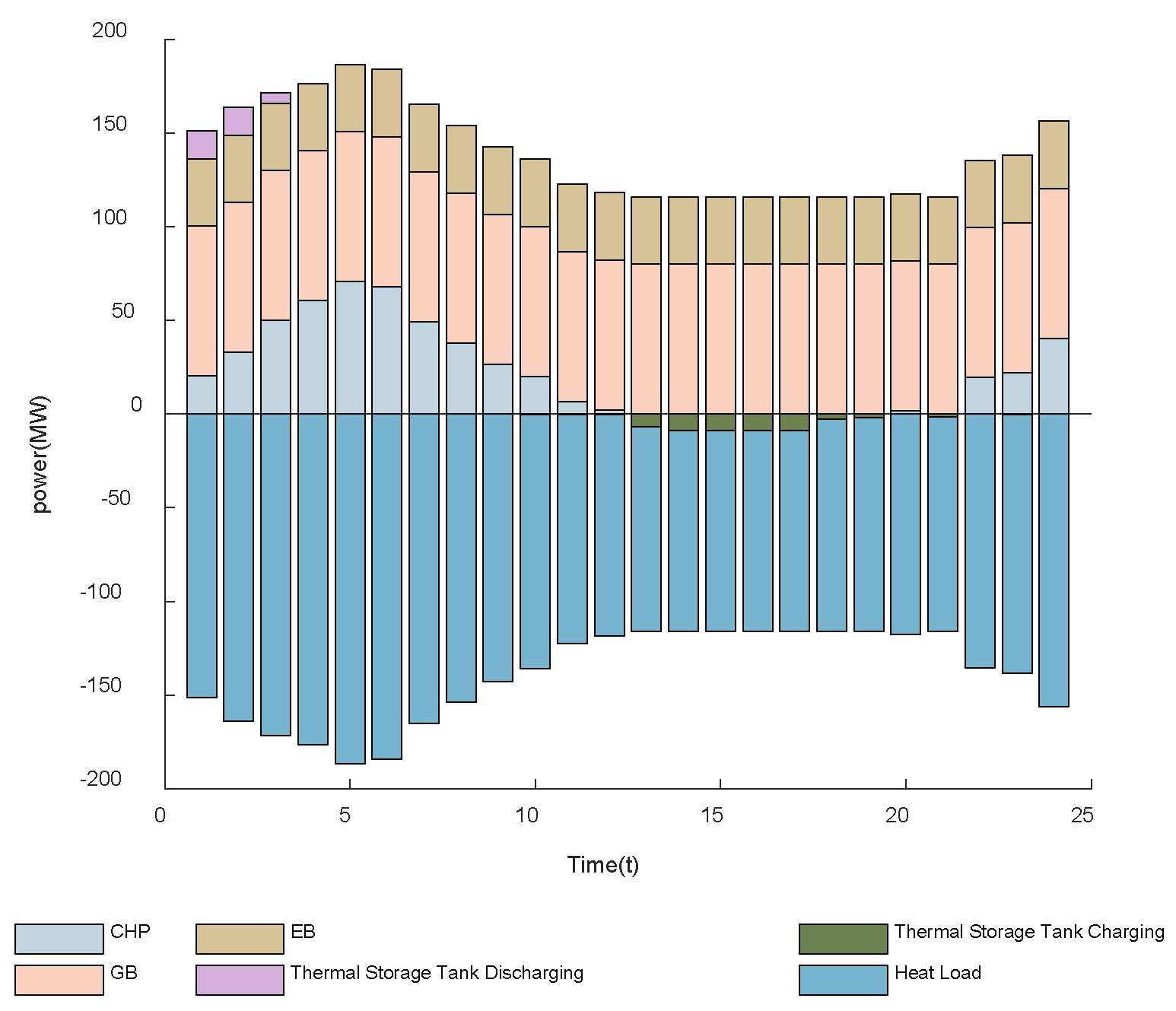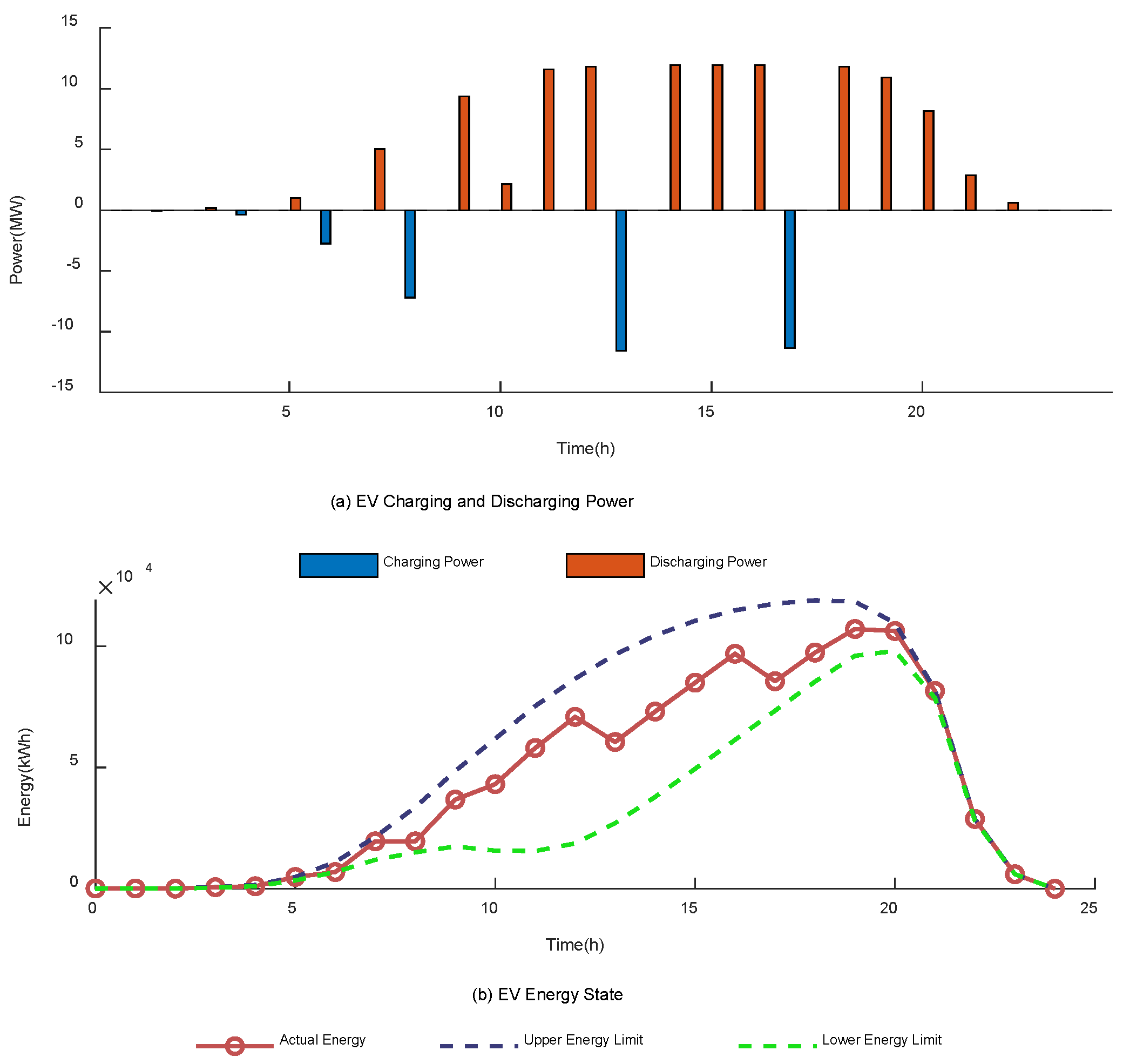Low-Carbon Economic Dispatch of Integrated Energy Systems with Electric Vehicle Participation
Abstract
1. Introduction
2. Modeling and Constraints of Multi-Energy Complementary Integrated Energy Systems
2.1. Cluster Electric Vehicle Model
- (1)
- Boundary model of a single EV
- (2)
- Cluster EV Modeling Based on the Virtual Battery Model
2.2. CHP-CCS-P2G Integrated Equipment Model
3. IES Stepwise Carbon Trading and Demand Response Model
3.1. Stepwise Carbon Trading Mechanism
- (1)
- Initial Carbon Emission Quota
- (2)
- Actual Carbon Emissions
- (3)
- Carbon Trading Cost
3.2. Demand Response Model
- (1)
- Transferable Demand Response
- (2)
- Curtailable Demand Response
- (3)
- Substitutable Demand Response
4. Low-Carbon Scheduling Model of the Park-Level Integrated Energy System
4.1. Objective Function
4.2. Energy Balance Constraints
5. Uncertainty of Wind and Solar Power and Scenario Reduction
6. Case Study Analysis
6.1. Basic Data
6.2. Verification of Low-Carbon Economic Dispatch Benefits in the Integrated Energy System
6.3. Simulation of Optimal System Operation
6.4. EV Charging/Discharging Profiles, SOC Regulation, and Frequency Response
6.5. Synergistic Benefits of EV Charging with Wind–Solar Generation and Market Prices
7. Sensitivity Analysis
8. Conclusions and Future Work
- (1)
- This paper develops a low-carbon economic dispatch model for a park-level integrated energy system that includes the coordinated operation of an electric vehicle (EV) cluster and a P2G–CCS scheme, and conducts quantitative comparative analysis of simulation results under multiple scenarios to obtain the following conclusions and outlook. Battery degradation and economic balance: During charging and discharging, EVs inevitably incur battery degradation cost. Simulation results indicate that the revenue from V2G ancillary services can offset about 91% of this degradation cost, keeping the net loss due to degradation at a very small and acceptable level. Although the degradation cost is not fully offset, its impact on the overall economic performance of the system is limited and does not reduce the value of EVs as flexible regulation resources.
- (2)
- System operation and flexibility improvement: By using a virtual-battery aggregation model, dispersed EVs are represented as a controllable aggregate capacity, which allows frequency regulation capacity constraints to be scheduled directly at the system level and, together with P2G–CCS, to form a coupling path from flexibility to renewable energy absorption and further to emission reduction. With the model size kept within a controllable range, this framework improves the system response speed, power regulation capability, and low-carbon economic performance. Case studies indicate that, compared with Scenario 2 without EVs, the participation of EVs in Scenario 3 further reduces the total system cost by 5.2% and exhibits a strong peak-shaving and valley-filling capability.
- (3)
- Low-carbon performance and integrated benefits improvement: By introducing P2G–CCS units and coordinating them with EVs, the system not only achieves efficient utilization of renewable electricity during surplus periods but also reduces its dependence on external gas purchases and significantly lowers carbon emissions. Compared with Scenario 2, the coordinated scheduling scheme that combines EVs with P2G–CCS reduces the system gas purchase cost by 4.0% and exhibits clear advantages in both operating cost and environmental performance, indicating good feasibility and development potential under low-carbon economic objectives.
- (4)
- This study builds a virtual-battery-based scheduling framework for EV clusters and represents battery degradation cost with a linearized model, which cannot fully capture the complex impacts of SOC and charge/discharge current on battery degradation. Future work will focus on developing a nonlinear degradation model that balances accuracy and computational efficiency. In addition, the study scope will be extended from park-level coordination to the regional level by coupling real-time electricity price signals with energy pipeline facilities, so as to achieve coordinated optimization of markets, technologies, and infrastructures.
Author Contributions
Funding
Data Availability Statement
Conflicts of Interest
Appendix A
Appendix A.1. Formatting of Mathematical Components
- (1)
- EL Model
- (2)
- Storage Tank Model
- (3)
- MR Model
Appendix A.2. Electric Boiler Model
Appendix A.3. Gas-Fired Boiler Model
References
- Peng, K.; Feng, K.; Chen, B.; Shan, Y.; Zhang, N.; Wang, P.; Fang, K.; Bai, Y.; Zou, X.; Wei, W.; et al. The global power sector’s low-carbon transition may enhance sustainable development goal achievement. Nat. Commun. 2023, 14, 3144. [Google Scholar] [CrossRef]
- Möller, T.; Högner, A.E.; Schleussner, C.-F.; Bien, S.; Kitzmann, N.H.; Lamboll, R.D.; Rogelj, J.; Donges, J.F.; Rockström, J.; Wunderling, N. Achieving net zero greenhouse gas emissions critical to limit climate tipping risks. Nat. Commun. 2024, 15, 6192. [Google Scholar] [CrossRef]
- Yan, R.; Wang, J.; Huo, S.; Qin, Y.; Zhang, J.; Tang, S.; Wang, Y.; Liu, Y.; Zhou, L. Flexibility improvement and stochastic multi-scenario hybrid optimization for an integrated energy system with high-proportion renewable energy. Energy 2023, 263, 125779. [Google Scholar] [CrossRef]
- Hinkelman, K.; Garcia, J.D.F.; Anbarasu, S.; Zuo, W. A Review of Multi-Energy Systems from Resiliency and Equity Perspectives. Energies 2025, 18, 4536. [Google Scholar] [CrossRef]
- Mancò, G.; Tesio, U.; Guelpa, E.; Verda, V. A review on multi energy systems modelling and optimization. Appl. Therm. Eng. 2024, 236, 121871. [Google Scholar] [CrossRef]
- Khou, S.A.; Olamaei, J.; Hosseini, M.H. Strategic scheduling of the electric vehicle-based microgrids under the enhanced particle swarm optimization algorithm. Sci. Rep. 2024, 14, 30795. [Google Scholar] [CrossRef] [PubMed]
- Wu, J.; Cheng, X.; Huang, H.; Fang, C.; Zhang, L.; Zhao, X.; Zhang, L.; Xing, J. Remaining useful life prediction of Lithium-ion batteries based on PSO-RF algorithm. Front. Energy Res. 2023, 10, 937035. [Google Scholar] [CrossRef]
- Mao, Y.; Cai, Z.; Jiao, X.; Long, D. Multi-timescale optimization scheduling of integrated energy systems oriented towards generalized energy storage services. Sci. Rep. 2025, 15, 8549. [Google Scholar] [CrossRef] [PubMed]
- Liu, Z.-F.; Liu, Y.-Y.; Jia, H.-J.; Jin, X.-L.; Liu, T.-H.; Wu, Y.-Z. Bi-level energy co-optimization of regional integrated energy system with electric vehicle to generalized-energy conversion framework and flexible hydrogen-blended gas strategy. Appl. Energy 2025, 390, 125868. [Google Scholar] [CrossRef]
- Jia, S.; Kang, X.; Cui, J.; Tian, B.; Xiao, S. Hierarchical stochastic optimal scheduling of electric thermal hydrogen integrated energy system considering electric vehicles. Energies 2022, 15, 5509. [Google Scholar] [CrossRef]
- Wang, Z.; Li, J.; Li, P.; Zhang, H.; Jurasz, J.; Wang, L.; Li, J.; Zheng, W. A comparative study on the performance of hybrid energy storage with electric vehicles and batteries in integrated energy system. J. Energy Storage 2025, 114, 115791. [Google Scholar] [CrossRef]
- Sagaria, S.; van der Kam, M.; Boström, T. Vehicle-to-grid impact on battery degradation and estimation of V2G economic compensation. Appl. Energy 2025, 377, 124546. [Google Scholar] [CrossRef]
- van der Zwaan, B.; Fattahi, A.; Longa, F.D.; Dekker, M.; van Vuuren, D.; Pietzcker, R.; Rodrigues, R.; Schreyer, F.; Huppmann, D.; Emmerling, J.; et al. Electricity- and hydrogen-driven energy system sector-coupling in net-zero CO2 emission pathways. Nat. Commun. 2025, 16, 1368. [Google Scholar] [CrossRef]
- Li, Y.; Zhang, F.; Li, Y.; Wang, Y. An improved two-stage robust optimization model for CCHP-P2G microgrid system considering multi-energy operation under wind power outputs uncertainties. Energy 2021, 223, 120048. [Google Scholar] [CrossRef]
- Marzi, E.; Morini, M.; Saletti, C.; Vouros, S.; Zaccaria, V.; Kyprianidis, K.; Gambarotta, A. Power-to-Gas for energy system flexibility under uncertainty in demand, production and price. Energy 2023, 284, 129212. [Google Scholar] [CrossRef]
- Faramarzi, H.; Ghaffarzadeh, N.; Shahnia, F. A new stochastic multi-objective model for the optimal management of a PV/wind integrated energy system with demand response, P2G, and energy storage devices. Front. Energy Res. 2025, 13, 1537703. [Google Scholar] [CrossRef]
- Wang, Y.; Zhou, Y. Equipment capacity matching methodology and techno-economic analysis for a novel low-carbon multi-energy system with the integration of oxy-coal combustion power plant and power-to-gas. Energy 2025, 322, 135693. [Google Scholar] [CrossRef]
- Pan, C.; Jin, T.; Li, N.; Wang, G.; Hou, X.; Gu, Y. Multi-objective and two-stage optimization study of integrated energy systems considering P2G and integrated demand responses. Energy 2023, 270, 126846. [Google Scholar] [CrossRef]
- Chen, L.; Liu, K.; Zhao, K.; Hu, L.; Liu, Z. Optimal scheduling of electricity-hydrogen-thermal integrated energy system with P2G for source-load coordination under carbon market environment. Energy Rep. 2025, 13, 2269–2276. [Google Scholar] [CrossRef]
- Yang, C.; Dong, X.; Wang, G.; Lv, D.; Gu, R.; Lei, Y. Low-carbon economic dispatch of integrated energy system with CCS-P2G-CHP. Energy Rep. 2024, 12, 42–51. [Google Scholar] [CrossRef]
- Huang, X.; Zhong, J.; Xiao, M.; Zhu, Y.; Zheng, H.; Zheng, B. Optimal and Sustainable Scheduling of Integrated Energy System Coupled with CCS-P2G and Waste-to-Energy Under the “Green-Carbon” Offset Mechanism. Sustainability 2025, 17, 4873. [Google Scholar] [CrossRef]
- Sattar, M.; Moghaddam, M.S.; Azarfar, A.; Salehi, N.; Vahedi, M. Co-optimization of integrated energy systems in the presence of renewable energy, electric vehicles, power-to-gas systems and energy storage systems with demand-side management. Clean Energy 2023, 7, 426–435. [Google Scholar] [CrossRef]
- Izadkhast, S.; García-González, P.; Frías, P. An aggregate model of plug-in electric vehicles for primary frequency control. IEEE Trans. Power Syst. 2015, 30, 1475–1482. [Google Scholar] [CrossRef]
- Zheng, Z.; Xiwang, A.; Sun, Y. Optimal Scheduling of Integrated Energy System Considering Hydrogen Blending Gas and Demand Response. Energies 2024, 17, 1902. [Google Scholar] [CrossRef]
- Zhou, C.; Xiang, Y.; Zhang, X.; Zhang, S.; Liu, Y.; Liu, J.; Hu, S. Regulation Potential and Economic Analysis of V2G Ancillary Services: A Case Study of Shanghai. Electr. Power Autom. Equip. 2021, 41, 135–141. (In Chinese) [Google Scholar] [CrossRef]
- Lu, L.; Wen, F.; Xue, Y.; Kang, J. Economic Analysis of Ancillary Services Provided by Electric Vehicles. Autom. Electr. Power Syst. 2013, 37, 43–49+58. (In Chinese) [Google Scholar]
- China Coal Market Network. China Coal Market Network EB/OL. Available online: https://www.cctd.com.cn/ (accessed on 25 May 2024).
- Chen, D.; Liu, F.; Liu, S. Optimal Scheduling of a Virtual Power Plant with P2G–CCS Coupling and Hydrogen-Blended Gas Units under Stepwise Carbon Trading. Power Syst. Technol. 2022, 46, 2042–2054. (In Chinese) [Google Scholar] [CrossRef]
- Sun, H.; Duan, J. Optimal Scheduling of an Integrated Energy System with Oxy-Fuel Combustion Power Plants and Hydrogen-Blended Gas Equipment. Therm. Power Gener. 2025, 54, 78–87. (In Chinese) [Google Scholar] [CrossRef]
- Yu, K.; Son, P.V. Review of trans-Mediterranean power grid interconnection: A regional roadmap towards energy sector decarbonization. Glob. Energy Interconnect. 2023, 6, 115–126. [Google Scholar] [CrossRef]
- Xu, M.; Zhao, D.; Yu, C.; Zhang, S.; Wan, J.; Li, W.; Liu, H. Research on the optimal scheduling strategy of the integrated energy system of electricity to hydrogen under the stepped carbon trading mechanism. Front. Energy Res. 2024, 12, 1410120. [Google Scholar] [CrossRef]













| Component | Parameter | Value |
|---|---|---|
| Coal Power Generation | Total output limit/MW Ramp rate limit/MW·h | 45/200 −20/20 |
| Power-to-Gas | Methanation efficiency | 0.7 |
| Electrolyzer efficiency | 0.85 | |
| Ramp rate limit/MW·h | 60 | |
| Carbon Capture and Storage | Maximum electricity consumption of the CCS system/MW | 150 |
| Absorption/regeneration efficiency | 0.95/0.9 | |
| Initial solvent storage/m3 | 10,000 | |
| Max. Liquid Storage Capacity/m3 | 30,000 | |
| Combined Heat and Power | Electric/thermal output limit/MW | 300/350 |
| Ramp rate limit/MW·h | −100/100 | |
| Electric Boiler | Thermal output limit/MW | 40 |
| Ramp rate limit/MW·h | −10/10 | |
| Thermal Storage Tank | Maximum charging/discharging rate/MW | 15 |
| Thermal storage capacity limits/MW·h | 20/120 | |
| Charging/discharging efficiency | 0.95 | |
| Battery Storage | Maximum charging/discharging rate/MW | 5 |
| Capacity range/MW·h | 10/60 | |
| Charging/discharging efficiency | 0.9 | |
| Hydrogen Storage Tank | Storage capacity range/kg | 1000/5000 |
| Maximum charging rate/kg·h | 1250 | |
| Charging/discharging efficiency | 0.98 |
| Device Type | Parameter Value | Value |
|---|---|---|
| Lower heating value of hydrogen | 1.4 × 108 J/kg | |
| Lower heating value of natural gas | 5.071 × 107 J/kg | |
| Standard density of CO2 | 1.964 kg/m | 3 |
| Carbon emission factor of natural gas | 1.9 kg CO2/m3 | |
| Carbon emission factor of the coal-fired unit | 0.7976 kg CO2/kWh | |
| Baseline carbon trading price | 140 CNY/t | |
| Growth rate of the carbon trading price | 0.3 | |
| Step length of the carbon allowance interval | 50 t | |
| Natural gas price | 3.5 CNY/m3 | |
| Coal price | 500 CNY/t |
| Indicator | Scenario 1 | Scenario 2 | Scenario 3 |
|---|---|---|---|
| Total cost | 1,957,438.86 | 1,711,893.24 | 1,622,061.49 |
| Carbon trading &sequestration | 283,964.52 | 152,486.35 | 206,052.71 |
| Coal-fired generation | 421,587.19 | 348,972.68 | 289,201.27 |
| Gas purchase | 1,118,903.77 | 1,082,457.11 | 1,039,290.00 |
| Battery degradation | - | - | 11,134.12 |
| V2G ancillary service revenue | - | - | 10,102.81 |
Disclaimer/Publisher’s Note: The statements, opinions and data contained in all publications are solely those of the individual author(s) and contributor(s) and not of MDPI and/or the editor(s). MDPI and/or the editor(s) disclaim responsibility for any injury to people or property resulting from any ideas, methods, instructions or products referred to in the content. |
© 2025 by the authors. Licensee MDPI, Basel, Switzerland. This article is an open access article distributed under the terms and conditions of the Creative Commons Attribution (CC BY) license (https://creativecommons.org/licenses/by/4.0/).
Share and Cite
Gu, J.; Huang, W.; Yan, C.; Feng, K. Low-Carbon Economic Dispatch of Integrated Energy Systems with Electric Vehicle Participation. Electronics 2025, 14, 4557. https://doi.org/10.3390/electronics14234557
Gu J, Huang W, Yan C, Feng K. Low-Carbon Economic Dispatch of Integrated Energy Systems with Electric Vehicle Participation. Electronics. 2025; 14(23):4557. https://doi.org/10.3390/electronics14234557
Chicago/Turabian StyleGu, Jingyao, Wei Huang, Chaohao Yan, and Kailun Feng. 2025. "Low-Carbon Economic Dispatch of Integrated Energy Systems with Electric Vehicle Participation" Electronics 14, no. 23: 4557. https://doi.org/10.3390/electronics14234557
APA StyleGu, J., Huang, W., Yan, C., & Feng, K. (2025). Low-Carbon Economic Dispatch of Integrated Energy Systems with Electric Vehicle Participation. Electronics, 14(23), 4557. https://doi.org/10.3390/electronics14234557





